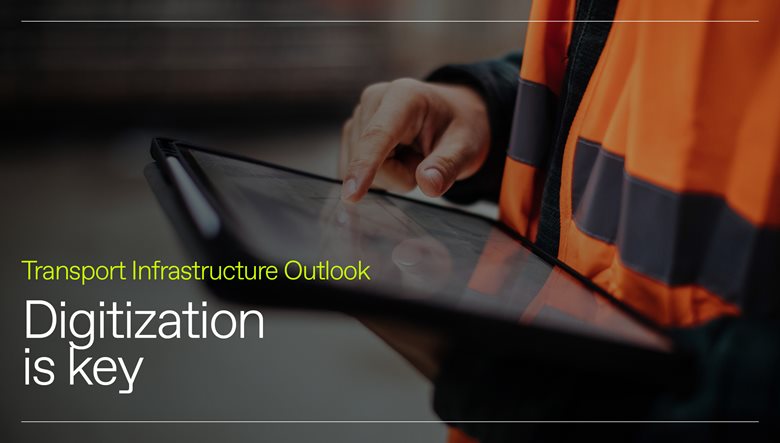Digitization the key to modern transport infrastructure
But budgets, skills gaps and systems challenges need to be addressed to fully realize the benefits.
By AnsaradaTue Aug 12 2025Industry news and trends, Innovation, Tenders

The digital transformation of transport infrastructure procurement is no longer futuristic, it’s a necessity. As governments and private developers race to deliver roads, railways, ports and smart mobility systems, adopting digital tools promises efficiency, transparency and cost savings.
Yet, the path to modernization is fraught with hurdles. From budget constraints to fragmented systems, the transport infrastructure procurement sector faces significant challenges in harnessing technology’s full potential. Drawing on our 2025 Transport Infrastructure Outlook Report, developed in partnership with Infralogic, this blog dissects the barriers to digitalization and explores strategies to overcome them.
1. Digitization constrained by budget limitations
More than a third (37%) of respondents cite budget constraints as the primary barrier to digitalizing procurement processes. This concern is particularly acute among government agencies and advisory firms, which often operate under strict taxpayer-funded budgets or competitive bidding pressures.
Ansarada’s Business Development Director ANZ, Craig McMahon, challenges the misconception digital tools are expensive: “While there are upfront costs, purpose-built solutions deliver rapid return on investment by shortening procurement timelines and reducing administrative overhead.”
For example, AI-driven tender platforms can cut bid evaluation time by 40%, accelerating project kickoffs.
It’s worth noting advisory firms face a paradox when it comes to helping their clients digitise their transport procurement. Clients expect digital tools as part of the firm’s service but rarely allow tech as separate line items in bids. To stay competitive, firms often opt for free, internal systems, which is a false economy that risks data security and efficiency.
“Using subpar tools to save costs is like building a highway with scaffolding, it might hold temporarily, but it’s prone to collapse,” says McMahon.
2. Lack of tech expertise slows digitization
Equally pressing is the 37% of respondents highlighting a lack of expertise as a critical barrier. Digital procurement requires proficiency in AI and data analytics, but these skills are typically scarce in traditionally analog sectors such as transport infrastructure.
The data shows there are significant regional disparities. In developed markets such as EMEA and the Americas, aging workforces struggle to upskill, with only 28% of EU procurement teams trained in digital tools.
Whereas in emerging markets such as Asia-Pacific and Africa rapid urbanization outpaces talent development, leaving megaprojects like Indonesia’s Trans-Java Toll Road reliant on foreign consultants.
Forward-thinking agencies are partnering with tech firms for tailored training programs. For instance, India’s National Infrastructure Pipeline now mandates digital literacy modules for project managers, aiming to upskill 50,000 professionals by 2026.
3. Siloed data hinders procurement processes
Siloed data plagues 35% of organizations, fragmenting workflows and delaying decisions. Privately-owned developers are hit hardest, with 43% citing data disarray as a top constraint.
As an example, a US port expansion project faced 18-month delays when environmental assessments, financial models and contractor bids were trapped in separate systems.
“Silos create blind spots. Teams waste time reconciling spreadsheets instead of focusing on strategic priorities,” says McMahon.
Collaboration is the solution and centralized digital platforms are gaining traction. Australia’s Level Crossing Removal Project (LXRP) used such a system to unify 30-plus stakeholders, cutting approval times by 60%.
4. Fragmented systems prevent a long-term perspective
The lack of global standards in transport infrastructure procurement means regions are adopting disparate systems.
Across EMEA, EU directives clash with national frameworks, complicating cross-border projects like the Scandinavian-Mediterranean Corridor. But across the Americas, California’s AI-driven procurement portal differs starkly from Texas’s legacy systems, hindering multi-state initiatives. In Asia-Pacific, Indonesia’s manual tendering contrasts with Singapore’s fully digital GeBIZ platform, creating inefficiencies in ASEAN collaborations.
Duplicated efforts and miscommunication inflates costs by 15% to 25%, with one Canadian rail project spending $2 million extra reconciling bids from provinces using different submission formats.
5. Addressing cybersecurity, compliance and legacy systems challenges
Digitalization does come with risks that require management, with 22% of respondents citing cyber breaches as a concern.
At the same time, navigating evolving regulations from the EU’s Corporate Sustainability Due Diligence Directive to US state-level ESG laws adds layers of complexity and 20% of firms struggle to align digital tools with compliance needs.
Integration challenges are also in the spotlight, with older systems resisting modernization, with 13% of agencies citing integration challenges. For example, Japan’s Shinkansen upgrades are hampered by 1980s-era procurement databases incompatible with cloud platforms.
6. Strategies for success towards digital procurement
At the outset, reframing budget mindsets is critical, as decision-makers often underestimate the long-term savings that come from upfront investments in digital tools.
Case studies bear this out; implementing a digital tendering system in Chile slashed procurement costs by 30%. This demonstrates how purpose-built solutions deliver rapid returns through streamlined timelines and less red tape.
There’s also potential for a rethink of how software costs could be explicitly included as line items in bids, rather than absorbed as hidden overheads.
Equally important is the cultivation of talent pipelines to bridge the digital skills gap. In India, 50,000 procurement professionals are being upskilled by 2026 through collaborations with tech firms like Infosys. This will better equip procurement teams with expertise in AI and data analytics.
Emerging markets stand to gain further by fostering global knowledge-sharing networks, leveraging insights from digital leaders like Singapore’s Smart Nation program to fast-track competency development and avoid reinventing the wheel.


